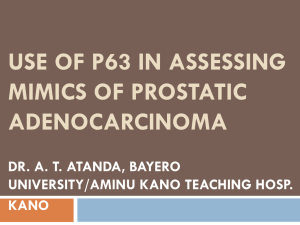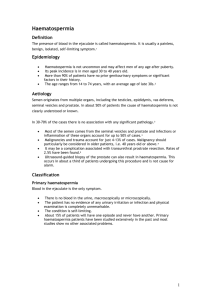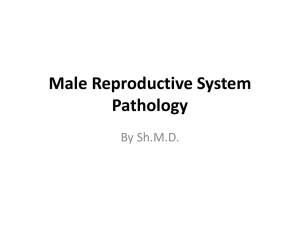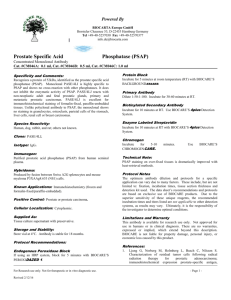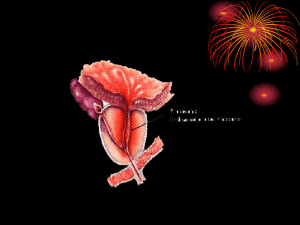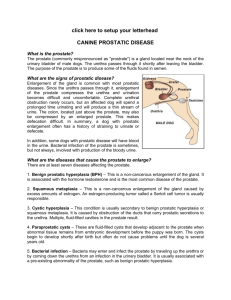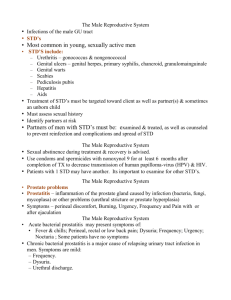inflammation_of_the_prostate
advertisement
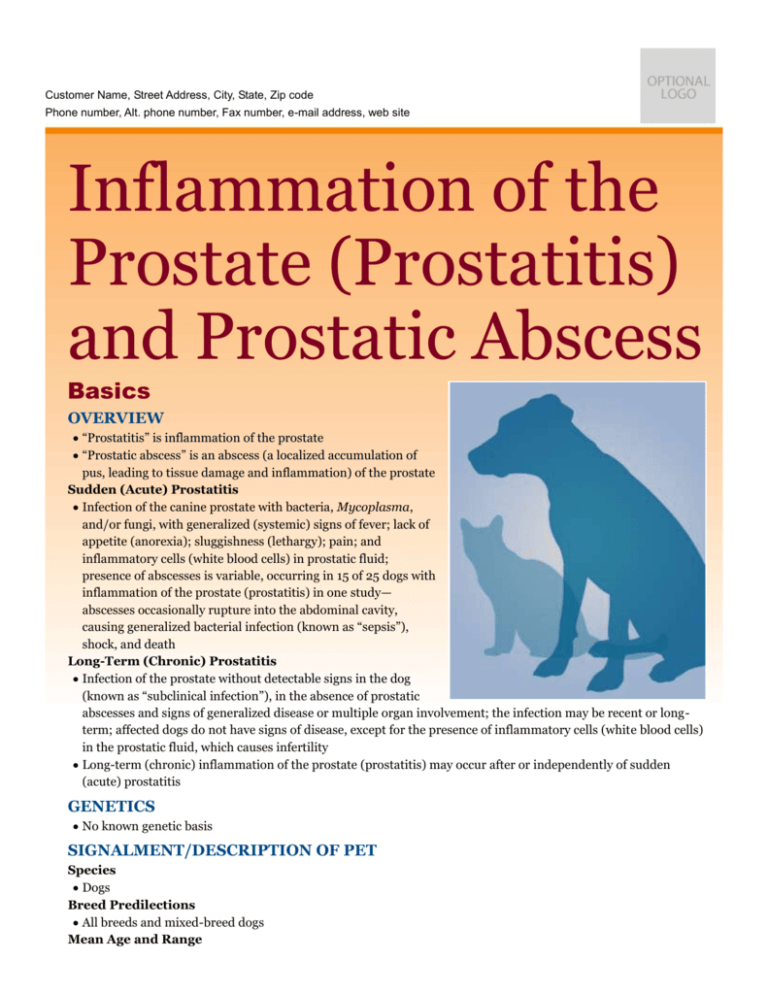
Customer Name, Street Address, City, State, Zip code Phone number, Alt. phone number, Fax number, e-mail address, web site Inflammation of the Prostate (Prostatitis) and Prostatic Abscess Basics OVERVIEW • “Prostatitis” is inflammation of the prostate • “Prostatic abscess” is an abscess (a localized accumulation of pus, leading to tissue damage and inflammation) of the prostate Sudden (Acute) Prostatitis • Infection of the canine prostate with bacteria, Mycoplasma, and/or fungi, with generalized (systemic) signs of fever; lack of appetite (anorexia); sluggishness (lethargy); pain; and inflammatory cells (white blood cells) in prostatic fluid; presence of abscesses is variable, occurring in 15 of 25 dogs with inflammation of the prostate (prostatitis) in one study— abscesses occasionally rupture into the abdominal cavity, causing generalized bacterial infection (known as “sepsis”), shock, and death Long-Term (Chronic) Prostatitis • Infection of the prostate without detectable signs in the dog (known as “subclinical infection”), in the absence of prostatic abscesses and signs of generalized disease or multiple organ involvement; the infection may be recent or longterm; affected dogs do not have signs of disease, except for the presence of inflammatory cells (white blood cells) in the prostatic fluid, which causes infertility • Long-term (chronic) inflammation of the prostate (prostatitis) may occur after or independently of sudden (acute) prostatitis GENETICS • No known genetic basis SIGNALMENT/DESCRIPTION OF PET Species • Dogs Breed Predilections • All breeds and mixed-breed dogs Mean Age and Range • Middle-aged; age range, 7–11 years Predominant Sex • Intact male dogs; “intact male” dogs have their male reproductive organs (testicles) and are capable of reproducing • May occur secondary to tumors or cancer of the prostate in neutered male dogs SIGNS/OBSERVED CHANGES IN THE PET Sudden (Acute) Prostatitis • Lethargy/depression • Lack of appetite (known as “anorexia”) • Straining to defecate (known as “tenesmus”) • Difficulty urinating (known as “dysuria”) • Fever (known as “pyrexia”) • Pain at prostatic or caudal abdominal palpation during physical examination by your pet's veterinarian • Bloody discharge from the urethra (the tube from the bladder to the outside, through which urine flows out of the body)Stiff hind-limb gait • Shock associated with generalized bacterial infection (sepsis; condition known as “septic shock”)—rare Long-Term (Chronic) Prostatitis • May have no detectable signs • Straining to defecate (tenesmus) • Difficulty urinating (dysuria) • Bloody discharge from the urethra (the tube from the bladder to the outside, through which urine flows out of the body) CAUSES • Infection of the enlarged prostate with bacteria moving up the urethra; possible bacteria include Escherichia coli, Staphylococcus, Streptococcus, Proteus mirabilis, Klebsiella, Enterobacter, Hemophilus, Pseudomonas, Pasteurella, anaerobic bacteria (bacteria that can live and grow in the absence of oxygen), and Mycoplasma (most common) • Infection of the enlarged prostate from a generalized (systemic) bacterial infection in the body, including Brucella canis • Generalized (systemic) or local puncture wound infection with Blastomyces dermatitidis (a fungus) RISK FACTORS • Increasing age; incidence is high in intact male dogs over 5 years of age • Presence of functional testicles in affected dogs • Enlarged prostate (known as “benign prostatic hypertrophy” [BPH]) • Tumors or cancer of the prostate—less common than BPH • Historical administration of male hormone (androgen) or female hormone (estrogen) • Impaired host-defense mechanisms (such as decreased ability to develop an immune response [known as “immunosuppression”], catheterization of the urethra); the “urethra” is the tube from the bladder to the outside, through which urine flows out of the body Treatment HEALTH CARE • Sudden (acute) inflammation of the prostate (prostatitis), prostatic abscess, and rupture of prostatic abscesses into the abdominal cavity are potentially life-threatening emergencies that can lead to shock associated with generalized bacterial infection (septic shock) and death; affected pets should be hospitalized and diagnostic samples (blood, urine, semen, imaging) collected immediately • Dogs with sudden (acute) prostatitis or prostatic abscess should receive antibiotics administered through an intravenous line • The pet should be assessed for likelihood of abscess rupture and inflammation of the lining of the abdomen (known as “peritonitis”), which warrants intravenous fluid therapy for shock associated with generalized bacterial infection (septic shock) • Dogs with long-term (chronic) prostatitis may be seen as outpatients for diagnostic procedures, and started on specific therapy when laboratory results are available ACTIVITY • Breeding should be avoided until bacteria have been cleared from the prostatic fluid SURGERY • Surgical management of prostatic abscesses should be deferred until after initiation of antibiotics and treatment to return the enlarged prostate to a more normal size (known as “prostatic involution”); involution is associated with resolution of abscesses, often making surgery unnecessary • Castration or neutering is recommended for induction of prostatic involution in non-breeding dogs with inflammation of the prostate (prostatitis); castration should be deferred until after identification and treatment (for at least one week) of the causative bacterial/fungal agent; alternatively, medical treatment to lead to involution of the prostate may be induced with finasteride • A variety of surgical techniques have been suggested for treatment of prostatic abscesses in dogs; however, these procedures have been associated with a high percentage of short- and long-term undesirable consequences, including recurrence of abscesses Medications • Medications presented in this section are intended to provide general information about possible treatment. The treatment for a particular condition may evolve as medical advances are made; therefore, the medications should not be considered as all inclusive ERADICATING INFECTION • Choice of antibiotics is based on bacterial and/or fungal culture and susceptibility findings in the prostatic fluid, antibiotic lipid solubility (which enhances its ability to move into prostatic tissue in therapeutic concentrations), and assessment of sudden (acute) or long-term (chronic) status of the infection • Antibiotics of choice in long-term (chronic) inflammation of the prostate (prostatitis) are those known to move into normal prostatic tissue in therapeutic concentrations, including chloramphenicol, erythromycin, fluoroquinolones, and trimethoprim; in sudden (acute) prostatitis, the blood-prostate barrier is assumed to be disrupted, and almost any antibiotic will reach the prostatic tissue in therapeutic concentrations • Emergency antibiotic treatment of choice in dogs with sudden (acute) prostatitis and/or abscess, administered after collection of prostatic fluid for culture, is amoxicillin/clavulanate with enrofloxacin INDUCING PROSTATIC INVOLUTION • Treatment to return the enlarged prostate to a more normal size • Treatment of choice for inducing permanent prostatic involution is castration • Alternatively, finasteride for 2–4 months induces involution of the prostatic tissue • Finasteride prevents conversion of testosterone to dihydrotestosterone (DHT; the hormone that is primarily involved in development of the prostate), thereby causing prostatic involution without adversely affecting libido or sperm production • Enlargement of the prostate (benign prostatic hypertrophy) recurs following cessation of finasteride therapy Follow-Up Care PATIENT MONITORING • Repeated evaluation of semen culture, cytology, and prostatic imaging • Intervals between reevaluations vary with severity of signs, presence of an abscess, selection of castration or finasteride therapy for prostatic involution, and use of the dog in a breeding program; intervals between evaluations range from 1 to 8 weeks, with recheck recommended prior to breeding • Continue monitoring until the dog has been castrated PREVENTIONS AND AVOIDANCE • Castration is recommended to induce prostatic involution (to return the enlarged prostate to a more normal size), resolution of benign prostatic hypertrophy, and prevention of recurrent infection POSSIBLE COMPLICATIONS • Recurrence of infection, if prostatic involution (to return the enlarged prostate to a more normal size) is not induced • Surgical drainage of abscesses is associated with many complications, including lack of control of urination (known as “urinary incontinence”); recurrence of abscesses; low levels of protein in the blood (known as “hypoproteinemia”); fluid buildup in the scrotum (known as “scrotal edema”); low red blood cell counts (known as “anemia”); generalized bacterial infection (sepsis); shock; and death EXPECTED COURSE AND PROGNOSIS • Prognosis is good to excellent, except in the case of rupture of prostatic abscesses into the abdominal cavity, with resulting inflammation of the lining of the abdomen (peritonitis) • Castration prevents recurrence and improves prognosis • Surgical management of prostatic abscesses is associated with complications and a poorer prognosis than medical/surgical induction of prostatic involution (to return the enlarged prostate to a more normal size) Key Points • Castration should be recommended for dogs with sudden (acute) inflammation of the prostate (prostatitis) and/or prostatic abscess, as castration induces permanent prostatic involution (to return the enlarged prostate to a more normal size) • If maintenance of breeding potential is necessary, long-term or intermittent treatment with finasteride is recommended to induce prostatic involution; routine rechecks at 2- to 3-month intervals for semen culture, semen cytology, and prostatic imaging are recommended • Prostatic enlargement (benign prostatic hypertrophy) recurs over time in intact male dogs after treatment with finasteride is discontinued, and BPH increases risk of recurrence of inflammation of the prostate (prostatitis) Enter notes here Blackwell's Five-Minute Veterinary Consult: Canine and Feline, Fifth Edition, Larry P. Tilley and Francis W.K. Smith, Jr. © 2011 John Wiley & Sons, Inc.
